To beat arm pain while making soap, use a stick blender in short bursts, set up an ergonomic workstation at elbow height, control temperatures (125-130°F) for faster trace, take strategic 5-minute breaks every 20 minutes, and try no-stir recipes with coconut and castor oils. Keep tools within easy reach, alternate sitting and standing, and invest in quality mixing equipment like mini frothers for mica mixing. These ten strategies will transform your soap making experience from painful to pleasurable.
The Power of the Stick Blender: Your Arm's Best Friend
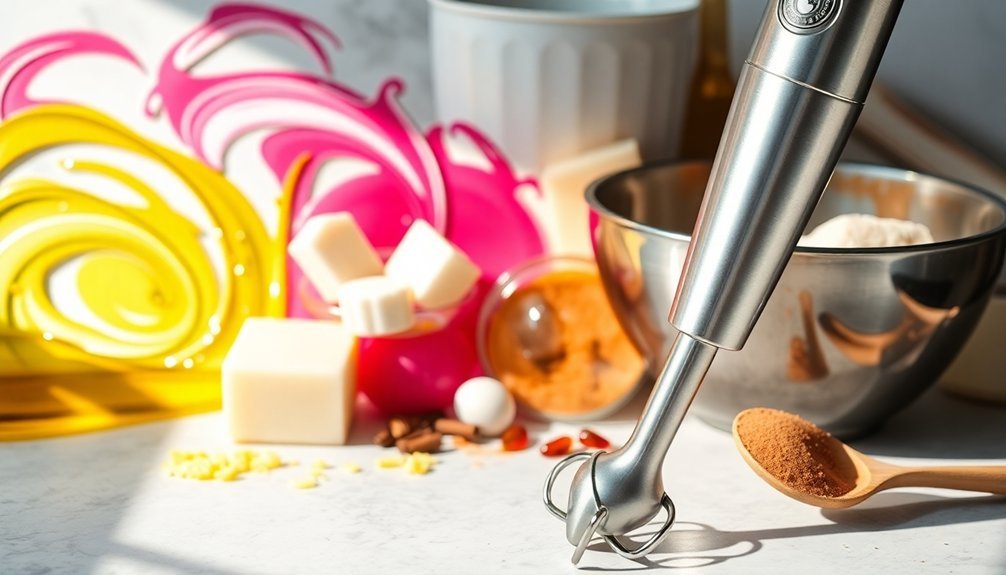
Three words can change your soap-making experience forever: get a stick blender. This essential tool automates mixing, greatly reducing the arm fatigue that comes with manual stirring in both cold and hot process methods.
Choose one with an ergonomic design, adjustable speed controls, and sturdy construction. For maximum effectiveness, use it in short 2-5 second bursts at low speed, followed by manual stirring. This technique prevents overheating while avoiding unwanted air bubbles in your mixture. A time experiment shows that stick blenders accomplish in minutes what could take an hour of vigorous stirring with traditional methods.
Pulse in short bursts, stir by hand between blends. This prevents both overheating and unwanted air bubbles in your soap mixture.
Unlike whisks or spatulas, a stick blender achieves trace much faster and more consistently. Look for models with detachable parts for easier cleaning, and consider dedicating one exclusively to soap making to prevent cross-contamination.
With proper care, a quality blender will serve you for 6-8 months of regular use.
Ergonomic Workstation Setup: Position Matters
Creating an ergonomic workstation isn't just for office workers—it's essential for soap makers too. When you're blending, pouring, and mixing for extended periods, your workstation height should align with your elbows.
Position your soap-making materials within easy reach to prevent unnecessary stretching and reaching that can strain your shoulders and wrists. Taking regular breaks during your soap-making sessions is crucial for preventing muscle fatigue and maintaining focus on your craft.
- Feel the relief of proper alignment as your shoulders relax naturally when your work surface is at the right height
- Experience the satisfaction of pain-free creativity when your wrists remain straight during stirring and pouring
- Enjoy longer crafting sessions without discomfort when you incorporate a sit-stand option for your soap-making area
Remember to adjust your position frequently, alternating between sitting and standing to reduce muscle fatigue while crafting your soaps.
Temperature Control for Faster Trace and Less Stirring
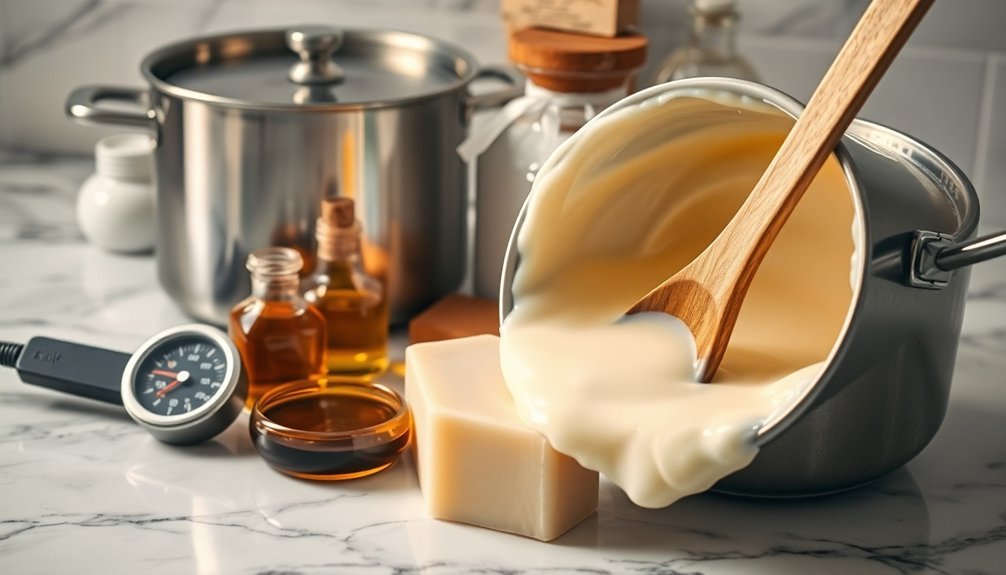
Temperature control serves as one of the most powerful yet underappreciated tools for reducing arm strain during soap making.
By working with oils and lye solution at the higher end of the ideal range (125-130°F), you'll greatly accelerate trace and reduce stirring time.
The heat transfer method offers an arm-saving approach – simply pour your hot lye solution directly over solid oils to melt them without additional heating equipment.
This technique leverages chemistry to do the work instead of your muscles. The lye water can reach temperatures of around 200°F, which efficiently melts hard oils and butters in about 10 minutes.
Consider adjusting your recipe if you're experiencing arm fatigue.
Incorporate harder oils and butters that accelerate trace, and reduce water content to reach trace faster.
Some fragrance oils naturally speed up saponification too.
Monitor temperatures throughout the process with a reliable thermometer to maintain the perfect balance between workability and efficiency.
Strategic Rest Breaks: When to Pause Your Soap Making
Your body sends clear signals before arm pain becomes severe, so learn to recognize muscle trembling, dull aches, or dropping speed as signs it's time to stop.
Set a timer for 20-minute work intervals with 5-minute breaks to prevent overtaxing your muscles during long soap-making sessions.
When you pause, try placing your arms at your sides or slightly elevated on a cushion to promote circulation and faster recovery between batches. Historically, soap makers using traditional spoons and paddles for mixing experienced similar strain issues when stirring ingredients for uniform saponification reactions.
Recognize Fatigue Signals
While immersed in the creative flow of soap making, many crafters miss the subtle warnings their bodies send until pain becomes impossible to ignore. Your body communicates fatigue well before significant pain develops.
Watch for slowing hand movements, diminished grip strength when holding your soap molds, or trembling hands while measuring essential oils.
Mental fatigue signs are equally important indicators that you need a break. If you're forgetting recipe measurements or feeling unusually frustrated with the process, it's time to step away. Consider testing your soap's pH levels accurately to ensure quality control when you return to work with refreshed focus.
- That moment when your wrist suddenly feels too weak to stir another batch
- The crushing disappointment of ruining a complex recipe because your tired mind skipped a step
- The relief that washes over you after taking that first, much-needed break
Timer-Based Rest Intervals
Setting a timer is arguably the most effective strategy to prevent arm pain during soap making sessions. Plan for 5-10 minute breaks after every 30-45 minutes of work, especially during physically demanding tasks like mixing heavy batters or cutting soap blocks.
During these strategic pauses, perform gentle stretches targeting your wrists, fingers, and forearms. This prevents the buildup of lactic acid that contributes to soreness. Don't wait until you feel discomfort—schedule breaks preemptively. This is especially important when making cold process soaps which require more physical stirring to reach proper saponification.
Use a kitchen timer or smartphone app with distinct alarms that won't be missed amid your workflow. Customize your intervals based on the complexity of your current soap project and your personal energy levels.
Remember that taking regular breaks isn't wasting time—it's ensuring you can continue creating beautiful soaps without painful consequences.
Recovery Position Techniques
Recovery position techniques extend beyond simply timing your breaks—they involve strategic body positioning that minimizes strain during both active soap making and rest periods.
Pay attention to your body's alignment while working, keeping your shoulders relaxed and wrists straight. When fatigue sets in, adjust your stance or switch to a different soap making task that uses different muscle groups. When making hot process soap, consider rotating stirring duties with a partner to give your arms a break during the continuous stirring phase.
- Notice the relief that washes over your tired arms when you alternate between stirring and pouring tasks
- Feel the renewed energy when you briefly step away from your workstation to stretch your hands overhead
- Experience the satisfaction of completing a soap batch without the usual aching shoulders by respecting your body's signals
Arm-Strengthening Exercises for Soap Makers
Soap makers who struggle with arm pain can benefit tremendously from targeted strengthening exercises. Focus on resistance band work for your upper body, incorporating bicep curls, tricep extensions, and shoulder raises to build resilience against strain.
Don't neglect your shoulders—perform daily shoulder rolls and pendulum exercises to improve mobility. Wall angels can enhance range of motion, offering better support during soap-making activities.
For elbow and forearm strength, try hammer curls and flexor stretches. You'll find wrist supination and pronation exercises particularly helpful for maintaining flexibility where you need it most. Gentle wrist rotations with extended arms can significantly reduce tension in the forearm area.
Remember to stretch regularly, holding each position for at least 5 seconds. If you don't have resistance bands, water bottles or light weights work well as substitutes.
Consistency is key—your efforts will pay off in reduced pain.
Hot Process Method: Reducing Manual Stirring Time
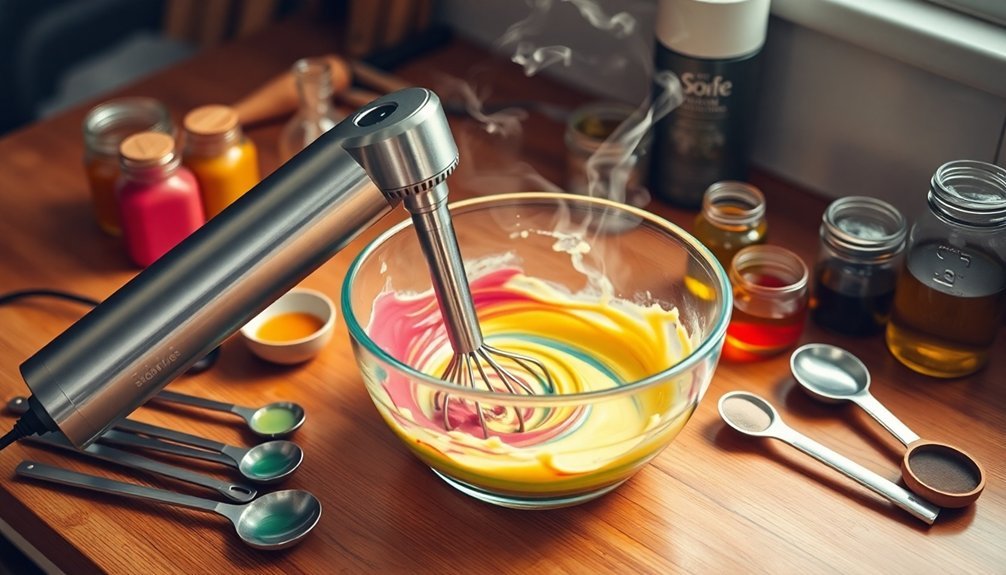
While strengthening your arms can help prevent pain, adapting your soap-making method offers another effective solution. The hot process technique accelerates saponification through heat, dramatically reducing the stirring time that causes arm strain.
You'll find that using a crockpot or slow cooker allows the heat to do much of the work for you, while an immersion blender can cut mixing time from hours to minutes. The heat transforms your soap batter into a thick, jelly-like texture, which requires less manual manipulation than cold process methods.
- Feel the satisfaction of watching your soap come together with minimal physical effort
- Experience the freedom from worry about lye burns during extended stirring sessions
- Enjoy creating beautiful soaps without the next-day soreness in your shoulders and arms
Pre-measure your ingredients and set up an ergonomic workspace to further minimize strain during the process.
Specialized Mixing Tools Worth the Investment
Investing in multi-speed stick blenders lets you control the intensity of your soap-making process, preventing unnecessary arm strain during longer mixing sessions.
Ergonomic handle designs distribute pressure more evenly across your hand and wrist, making them worth the extra cost for regular soap makers.
Automated stirring devices, while pricier than basic equipment, can completely transform your production by handling the repetitive mixing that typically causes the most discomfort.
For larger soap batches, a handheld power drill with a paint mixing attachment can provide significant arm relief at a more affordable price point than commercial stick blenders.
Multi-Speed Stick Blenders
When it comes to reducing arm strain, multi-speed stick blenders represent one of the most significant investments you can make for your soap-making practice.
With variable speed controls, you'll gain precise adjustments during emulsification, preventing the arm fatigue that comes from manually mixing to trace.
Look for models with detachable shafts like the All-Clad KZ750D for easier cleaning, or the Cuisinart CSB-79 with multiple speed settings for better control.
Remember to use your blender in short intervals to prevent overheating and extend its lifespan. Similar to how researchers evaluate model outputs in structured JSON formats, tracking your blending performance can help you optimize your technique.
- Feel the relief as your blender effortlessly brings your soap to trace in minutes instead of hours
- Experience the freedom of creating larger batches without fear of exhaustion
- Enjoy the satisfaction of perfectly emulsified soap without the aching shoulders
Ergonomic Handle Designs
Beyond choosing the right stick blender, the design of your mixing tools' handles plays a major role in preventing arm pain. Look for handles with non-slip textures and soft cushioning that absorbs vibration during long mixing sessions.
Curved or slanted handles allow for natural hand movement and easier access to deep soap molds. Tools with contoured grips featuring finger indentations provide better control while reducing strain. The KitchenAid Cordless Hand Blender offers excellent freedom of movement that helps reduce arm strain during extended soap making sessions.
The weight and balance of your tools matter too—lightweight materials like aluminum or plastic can greatly decrease fatigue.
When investing in specialized mixing tools, consider the economic benefits. Ergonomic designs increase your productivity by allowing longer work sessions without discomfort.
You'll create more consistent textures and professional results while protecting yourself from potential repetitive strain injuries. The initial cost pays off through improved efficiency and reduced health risks.
Automated Stirring Devices
Automated stirring devices revolutionize the soap making process by completely eliminating the repetitive arm motion that causes pain and fatigue.
These specialized tools range from compact magnetic stirrers ideal for small batches to powerful overhead stirrers for larger production volumes.
You'll find options powered by batteries or electrical outlets, offering flexibility for your workspace setup.
With variable speed control features, you can adjust mixing intensity based on your recipe's requirements while maintaining consistent quality.
The Soap stirrer is particularly recommended for those who value aesthetics and portability when making small batches of soap.
- Freedom at last – imagine making soap while your hands remain pain-free to focus on creative aspects
- Silent efficiency – watch your soap blend perfectly while you sip tea and plan your next batch
- Worth every penny – the investment pays for itself in saved time and reduced physical therapy bills
Post-Soap Making Recovery Techniques
The satisfying craft of soap making often comes with physical challenges, particularly arm strain and fatigue. After completing your batch, proper recovery techniques can prevent lasting discomfort.
Incorporate regular stretching to alleviate muscle tension, and don't underestimate the power of adequate rest and hydration. This recovery period is particularly important since the soap itself requires a 4 to 6 weeks curing process before use. Try applying cold compresses to reduce any swelling or pain in overworked arms. Gentle arm movements will help maintain blood circulation while your muscles recover.
Create a post-soap making routine that includes low-intensity cool-down activities. This adjustment period gives your body time to adapt after the repetitive motions of stirring and pouring.
Remember that recovery isn't just physical—practicing stress management techniques can greatly improve your overall soap making experience and reduce tension that contributes to arm pain.
Pre-Mixing Strategies to Minimize Total Stirring Time
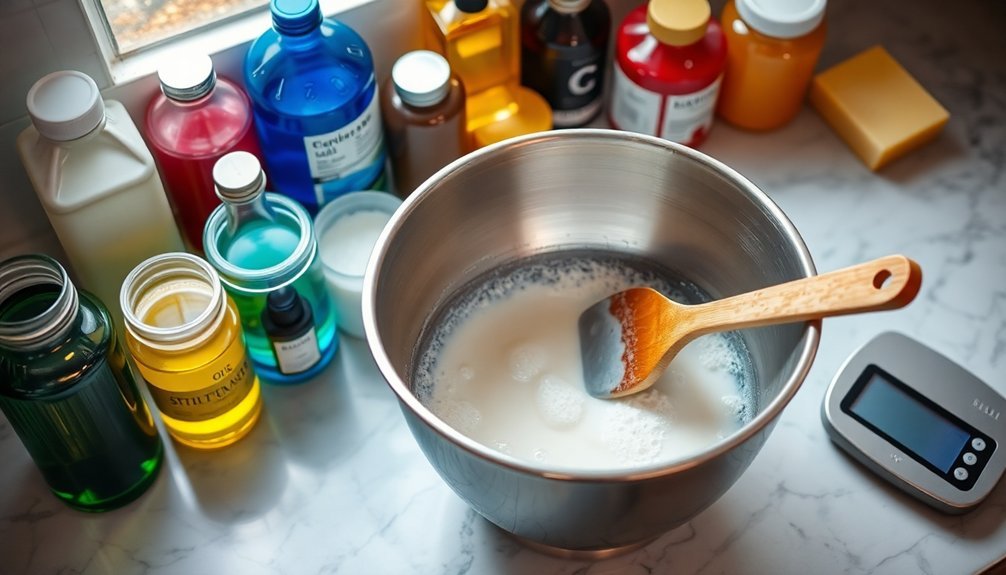
Preparing efficiently before you begin the soap-making process can dramatically reduce the arm strain caused by extended stirring sessions.
Pre-mix your colorants with oils or glycerin to prevent clumping and guarantee they'll blend smoothly when added to your soap batch. Set up a mini frother for mixing micas and oxides—this small tool saves considerable arm power compared to manual stirring. Using a quality immersion blender will significantly speed up the tracing process compared to manual stirring.
Have your lye solution prepared and cooling while you heat your oils to the desired temperature. This parallel preparation saves time and reduces the need for extended stirring as you wait for components to reach compatible temperatures.
- Feel the relief of completing a soap batch without that familiar burning sensation in your forearms
- Enjoy the satisfaction of efficient workflow with everything at your fingertips
- Experience the pride of professional-quality soap made with less physical strain
No-Stir Soap Recipes That Preserve Your Arm Strength
For soap makers seeking true arm relief, no-stir soap recipes offer the supreme solution when pre-mixing strategies aren't enough.
These formulations focus on faster-tracing ingredients like coconut oil, palm oil, and tallow that considerably reduce stirring time.
Add castor oil to enhance emulsification and speed up the tracing process. A well-balanced recipe with coconut oil, olive oil, palm oil, and castor oil will trace quickly while maintaining quality.
Castor oil is your trace-accelerating secret weapon, creating quick-setting soaps that don't sacrifice quality or performance.
Temperature management is critical—keep your oils and lye solution at ideal temperatures to achieve trace sooner. The digital thermometer ensures you achieve the optimal consistency resembling thin custard at the trace stage.
For almost hands-free soapmaking, try the slow cooker method where heat does most of the work.
While not entirely stir-free, using a stick blender dramatically cuts manual effort.
These techniques preserve your arm strength while saving time and allowing you to continue creating beautiful soap without pain.
Frequently Asked Questions
Can Certain Soap Ingredients Cause More Arm Strain Than Others?
Yes, certain soap ingredients can strain your arms more. You'll find thick ingredients like shea butter and exfoliants like crushed walnut shells require more vigorous mixing, increasing your arm strain compared to liquid additives.
How Do Weather Conditions Affect Soap Mixing Difficulty?
Weather greatly impacts your soap mixing experience. In hot conditions, your batter traces quickly, requiring less stirring. Cold environments create thicker oils that you'll find harder to blend, increasing arm strain.
Is Melt-And-Pour Soap Making Better for Arthritis Sufferers?
Yes, you'll find melt-and-pour soap making ideal if you have arthritis. It doesn't require lye handling, needs minimal stirring, reduces joint strain, and lets you incorporate therapeutic ingredients while being easier on your hands.
Can Wearing Compression Sleeves Help Prevent Soap Making Pain?
Yes, compression sleeves can help prevent pain while making soap. They'll improve circulation, reduce muscle fatigue, and provide stability during repetitive motions. For best results, choose sleeves with graduated compression designed for arm support.
Are There Soap Molds That Reduce Unmolding-Related Arm Strain?
Yes, you'll find strain-reducing options in oval soap molds with smooth finishes, silicone molds that release easily, and quick-release designs. Freezing soap briefly before unmolding also greatly reduces the force needed.
In Summary
Don't let arm pain keep you from your soap-making passion. You've now got ten effective ways to prevent and manage discomfort while creating beautiful soaps. Whether you're upgrading your equipment, adjusting your technique, or strengthening your body, these strategies will help you craft batch after batch with less strain. Try implementing just one tip at a time, and you'll notice the difference immediately.

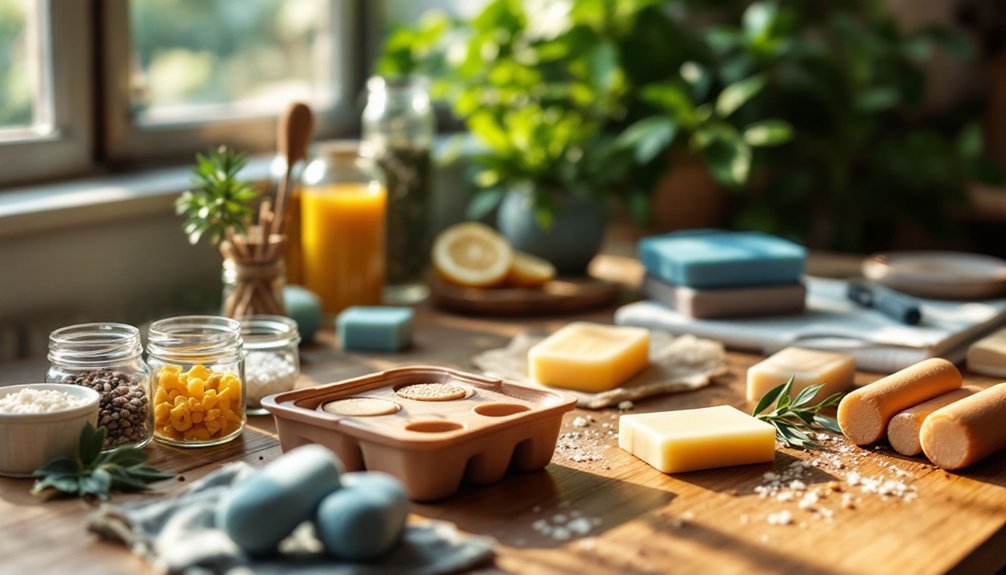



Leave a Reply